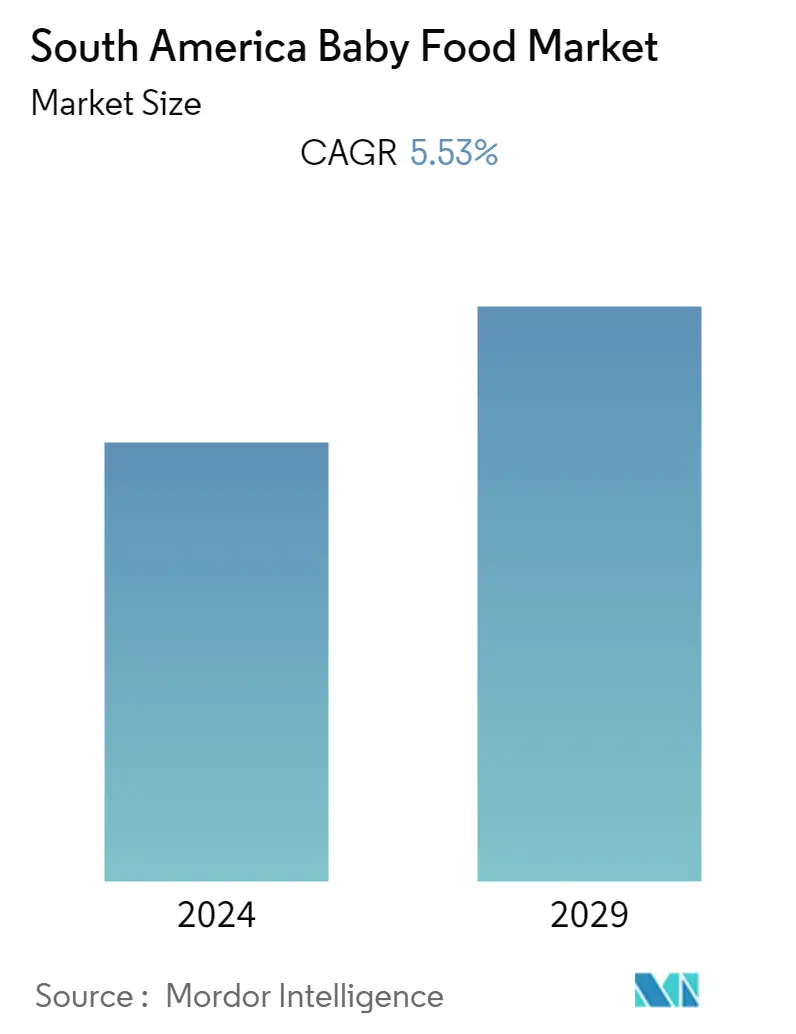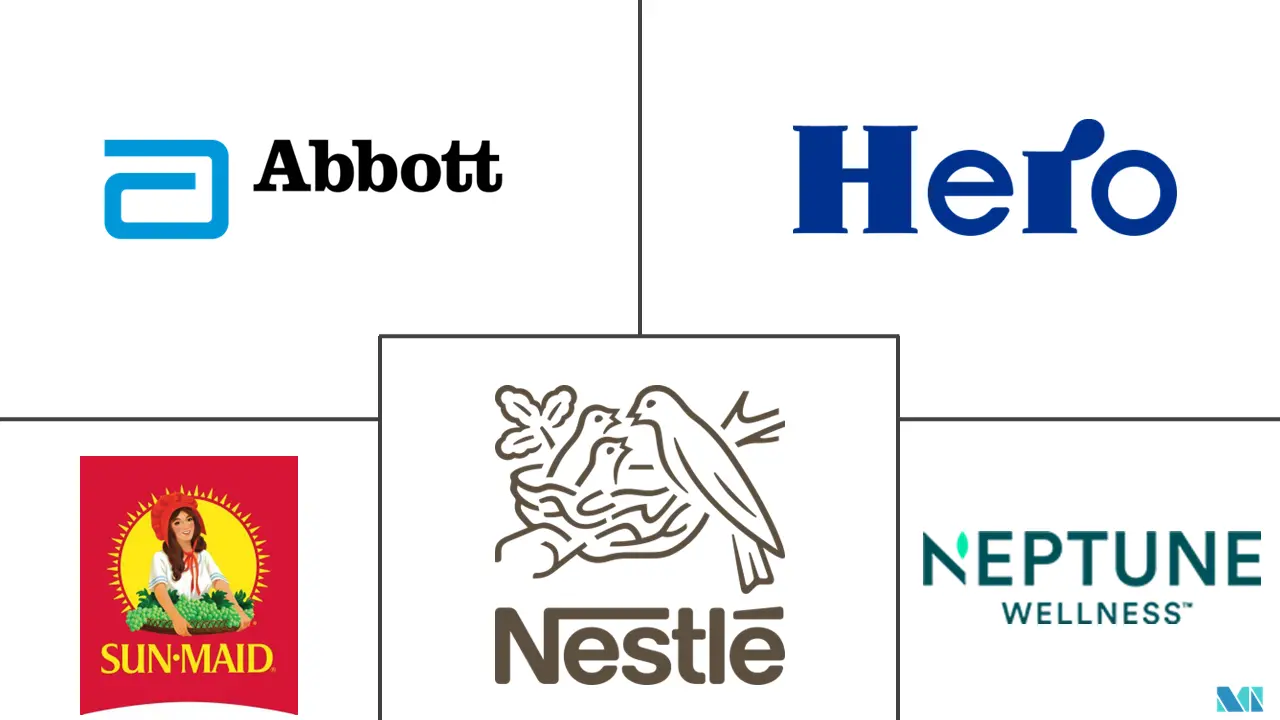Market Size of South America Baby Food Industry

| Study Period | 2019 - 2029 |
| Base Year For Estimation | 2023 |
| Forecast Data Period | 2024 - 2029 |
| Historical Data Period | 2019 - 2022 |
| CAGR | 5.53 % |
| Market Concentration | Low |
Major Players
*Disclaimer: Major Players sorted in no particular order |
South America Baby Food Market Analysis
The South American market is expected to register a CAGR of 5.53% over the next five years.
- Mothers in South America are becoming very conscious of their kid's health and well-being. Due to the rising disposable income and the increasing working population of women, they prefer baby food for their children.
- Growing urbanization and increased packaged food consumption are driving the growth of packaged baby food. The market players produce sustainable and nutrient-rich baby food to give babies strong immunity.
- Dried baby foods are in demand in the region owing to their convenience and easy-to-mix properties. As women work outside their houses, they need more time to cook for their babies. Hence, the region's demand for processed and prepared baby food is growing.
- Additionally, the availability of baby food in supermarkets/hypermarkets, retail stores, and drug stores is also driving the market's growth. The easy availability and variety of baby food products in supermarkets are grabbing consumer attraction.
- Online retail channels like e-commerce websites also provide a variety of baby food products with offers and discounts. The market players are producing products with fortified nutrients like vitamins, minerals, and human milk oligosaccharides to build strong immunity among babies at the early stages of growth. The population of South America is growing steadily, due to which demand for baby food products is also increasing in the region.
South America Baby Food Industry Segmentation
Baby food is any soft, easily digestible meal created particularly for human babies aged 4-6 to two years old.
The South American baby food market is segmented by type, distribution channel, and country. The market is segmented by type into milk formula, dried baby food, prepared baby food, and other baby food. The market is segmented by distribution channel into supermarkets/hypermarkets, convenience stores, online retail stores, and other distribution channels. By geography, the market is segmented into Brazil, Argentina, and the Rest of South America.
For each segment, the market sizing and forecasts are done in value terms of USD million.
| Type | |
| Milk Formula | |
| Dried Baby Food | |
| Prepared Baby Food | |
| Other Types |
| Distribution Channel | |
| Hypermarket/Supermarket | |
| Drugstores/Pharmacies | |
| Convenience Stores | |
| Other Distribution Channels |
| Geography | |||||
|
South America Baby Food Market Size Summary
The South American baby food market is experiencing significant growth, driven by increasing urbanization, rising disposable incomes, and a growing working population of women. As mothers become more health-conscious, there is a notable shift towards packaged and processed baby food, which offers convenience and nutritional benefits. The demand for dried baby foods is particularly high due to their easy-to-mix properties, catering to the busy lifestyles of working mothers. The market is further bolstered by the widespread availability of baby food products in supermarkets, hypermarkets, retail stores, and online platforms, making it easier for consumers to access a variety of options. This trend is supported by the production of sustainable and nutrient-rich baby foods, which are designed to enhance immunity and support early growth stages.
The market is characterized by a preference for organic and chemical-free baby food products, as consumers are willing to invest in high-quality nutrition for their children. The introduction of fortified baby food products, enriched with vitamins, minerals, and human milk oligosaccharides, is gaining traction as parents seek to provide optimal nutrition. The Brazilian market, in particular, is witnessing a rise in demand for infant milk and baby formulas, driven by an increasing population and heightened awareness of child health and nutrition. The competitive landscape is fragmented, with both global and regional players like Abbott Nutrition, The Hero Group, Sun-Maid Growers California, Nestlé SA, and Neptune Wellness Solutions leading the market. These companies are focusing on innovation and product development to meet the evolving consumer demands for organic and nutrient-rich baby food options.
South America Baby Food Market Size - Table of Contents
-
1. MARKET DYNAMICS
-
1.1 Market Drivers
-
1.2 Market Restraints
-
1.3 Porter's Five Force Analysis
-
1.3.1 Threat of New Entrants
-
1.3.2 Bargaining Power of Buyers/Consumers
-
1.3.3 Bargaining Power of Suppliers
-
1.3.4 Threat of Substitute Products
-
1.3.5 Intensity of Competitive Rivalry
-
-
-
2. MARKET SEGMENTATION
-
2.1 Type
-
2.1.1 Milk Formula
-
2.1.2 Dried Baby Food
-
2.1.3 Prepared Baby Food
-
2.1.4 Other Types
-
-
2.2 Distribution Channel
-
2.2.1 Hypermarket/Supermarket
-
2.2.2 Drugstores/Pharmacies
-
2.2.3 Convenience Stores
-
2.2.4 Other Distribution Channels
-
-
2.3 Geography
-
2.3.1 South America
-
2.3.1.1 Brazil
-
2.3.1.2 Argentina
-
2.3.1.3 Rest of South America
-
-
-
South America Baby Food Market Size FAQs
What is the current South America Baby Food Market size?
The South America Baby Food Market is projected to register a CAGR of 5.53% during the forecast period (2024-2029)
Who are the key players in South America Baby Food Market?
Abbott Nutrition, The Hero Group, Sun-Maid Growers California, Nestlé SA and Neptune Wellness Solutions are the major companies operating in the South America Baby Food Market.

